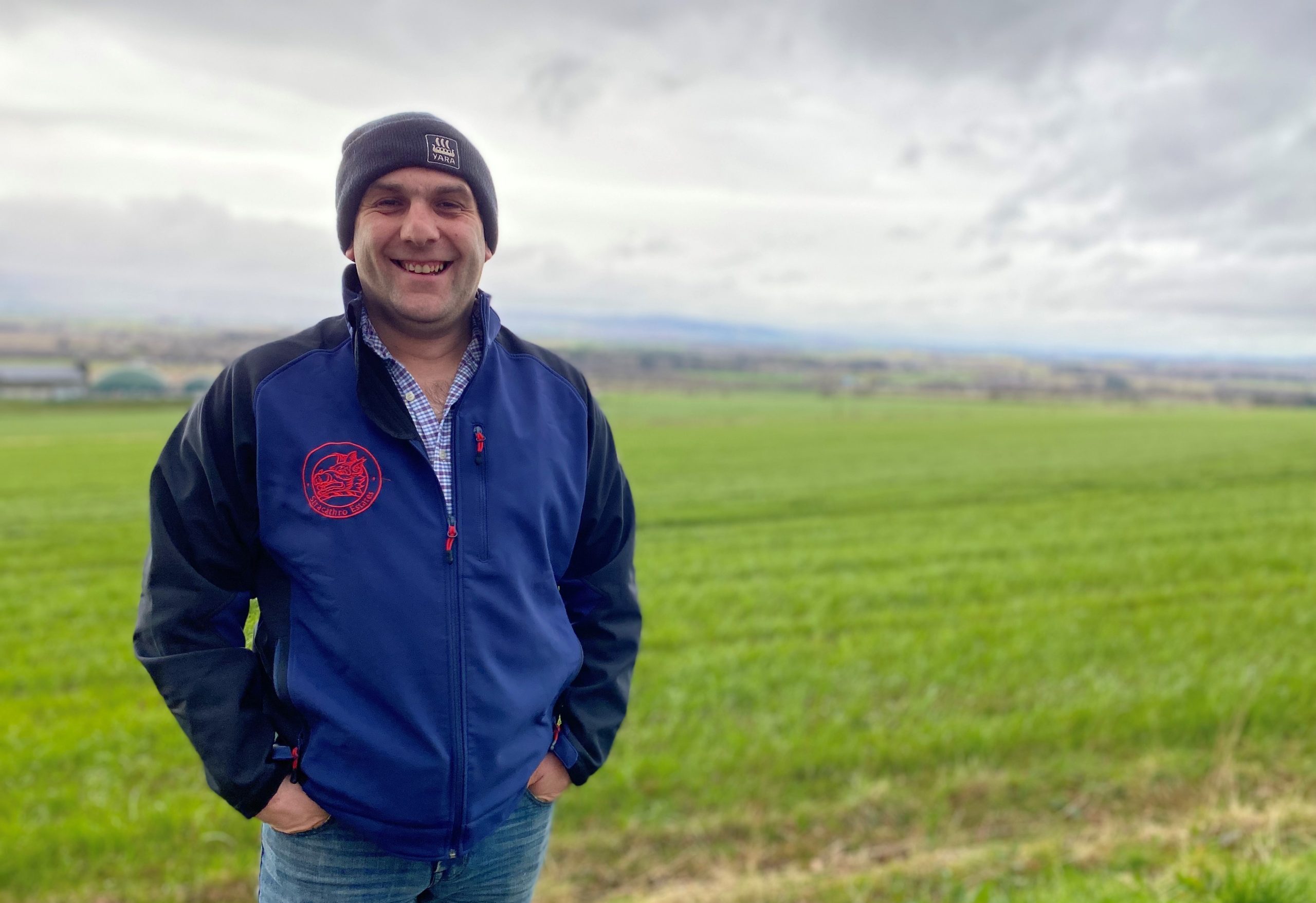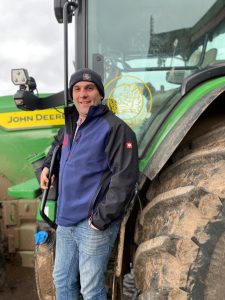
Harvesting in each of the 12 months of the year has brought a different perspective to crop management for farm manager and Scottish Agronomy member, Iain Wilson. Iain is a year into the role at the 4000-acre Stracathro Estate near Laurencekirk, where alongside conventional annual cropping for the milling and feed market, the estate is growing and harvesting year-round to feed an AD plant.
Installed six years ago, the AD plant supplies approximately four million cubes of gas to the National Grid every year. Stracathro is contracted to feed the plant and provide the feedstock, which, as one of the stipulations, is solely crops grown on the farm.
Planning for a harvest in every month needs a well-considered strategy, but it’s a challenge he is enjoying, says Iain:
“We need to fill the AD plant with the same tonnage every day and with crops that will provide similar energy so the power supply remains reasonably consistent. There’s not a month in the year when we’re not harvesting. We need to plan the rotation, establishment and growth to make sure there’s a constant supply for the AD plant.”
Between 100-110 tonnes are fed to the plant each day. From October to May, fodder and sugar beet is harvested and makes up 30-35% of the ration. Forage rye, arable silage and grass silage make up the rest of the ration.
The aim is to lift 500 tonnes of beet every 10-14days during the winter months, which is washed and chopped prior to feeding. Grass, a 50/50 Italian/Hybrid mix, wholecrop rye and wholecrop arable silage are ensiled once cut and stored on over a hectare of silage pits. With the AD plant, they are managing feedstock and slurry for the equivalent of 2000 dairy cows.
The conventional cereal harvest includes Winter and Spring Wheat, and Winter and Spring Oats, sold largely through GrainCo and OatCo. Last year Iain re-introduced oilseed rape, which Stracathro had stopped growing with the arrival of the AD plant, in order to clean up cereal volunteers, widen the rotation and help extend the harvest.
Iain has been a member of Scottish Agronomy for many years, originally as he was growing up, joining meetings with his father, and he has taken his membership with him as he has moved to his different roles as Farm Manager: 
“The Scottish Agronomy group meetings have been an invaluable source of local knowledge and experience when I’ve moved into a new area. It’s the advice you get and the wider conversations you have – it’s good to meet up with others and learn from them what has and hasn’t worked. I’ve also learned from experience the amount of money I can save if I keep my agronomy and my chemical buying separate. In my last job, I did a side-by-side trial with Scottish Agronomy advice and selectively buying chemicals to compare with the input recommendations from a trade agronomist, and I saved my year’s salary in chemical.”
Iain’s focus is on getting the soils right and varieties that work for him, using Scottish Agronomy trials as a guide:
“I want to keep it simple. The scale of Stracathro means I can’t afford to take up time with dirty varieties, and chemicals are becoming more expensive and less effective. The days of reaching for the chemical can to solve every problem I think are gone. I really value the trials Scottish Agronomy does on varieties and inputs so I can target nutrition and protection. In my role, I have to be able to justify every penny to the owners. I will intentionally miss a pass from time to time so I know if what I’m doing is working, and I like to challenge my agronomist!”
Iain takes an equally pragmatic approach to weather windows and trialling establishment techniques to get the most from all of the crops and work flow.
He will min till as much as possible – “not particularly as a regenerative approach, but because the plough is slow and expensive in time and labour, but I’m not afraid to use it if we have to” – and drill as early as possible, ideally in August, to make the most of the better weather and drier soil.
Early sown crops also allow him to make the most of grazing in the rotation. Iain trialled 1000 sheep grazing on 400 acres of wheat and oats between September and December last year, having successfully introduced the same in his previous role at Tulloch Farms.
“It eliminates the need for T0s, which I was grateful for in this wet spring, and for growth regulators; it has also helped even the tillers out on forward crops and held back any weeds giving me a longer window to get them sprayed come spring, so it’s worked well and we’ll increase the acreage this year.”
There is an emphasis on efficiency at Stracathro: crops grown in blocks so they can all be fertilised or sprayed in one day. Straddling a busy dual carriageway as well as a network of narrow roads on farm, the flow of machinery is well thought out, including a one-way system so they are not meeting on the road, losing time in passing or damaging verges; or crossing the A90 more than necessary.
Other measures such as nurse tanks parked in the fields so slurry tankers can fill up on site makes systems more lean, and lighter machinery allows them onto the fields as soon as the NVZ window opens.
As part of the negotiations for the installation of the AD plant, the owners, the Campbell-Adamsons, secured a closed system with feedstock produced exclusively from crops grown on the farm – no waste or crops from elsewhere – and the same nutrient cycle goes out onto the farm. The digestate from the plant is separated: the liquid goes on growing crops and solid as a soil conditioner ahead of the crops.
“The circular nutrition allows for consistency in energy production as well as crop nutrition,” explains Iain. “It’s clear to see that the soil has improved over the last six years.”
Iain works closely with the owners, the Campbell-Adamson family, father Hughie and son James at the helm. Traditionally a mixed farm, with livestock summered in the Angus glens, the arable farming remains the main hub, but the estate continues to diversify, particularly with renewables: solar panels, wind power and biomass already in place and further solar planned for an outlying piece of land.
The family has a strong sense of responsibility to the environment as well as to the local community. They have worked hard to keep the local school and amenities open, and recently built 6 affordable houses on the estate. They also host RHET visits for school children to showcase sustainable farming.
All drilling, cultivating and harvesting is undertaken by the team of five alongside Iain with contractors brought in at the July peak of the second cut of silage and rye harvest so the rye doesn’t over mature and lose its feed value.
“We don’t have the peaks and troughs of harvest of a traditional arable unit, but it also means we are busy all year round. We are fortunate to have a guaranteed customer in the AD plant, and the price of every crop in negotiated before it goes in the ground which really helps with planning. We try and manage to keep working hours to a minimum for the whole team, have the right equipment to make it work, and we have an additional member of staff on full-time estate maintenance to keep on top of jobs traditionally kept for the winter on an arable unit, such as drainage and ditching.”
Anyone who knows Iain will know he loves a trial, and he continues to experiment at Stracathro to improve efficiencies and crop yields. As well as sheep grazing and including more hard wheats in the rotation, this year they will be trialling bruising wheat for the AD plant for the period between May and October when they are lean on beet. They have also erected a new purpose-built shed to store the beet to catch the sugar syrup which they noticed was running off the beet once washed, to put back into the plant.